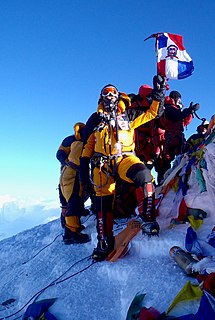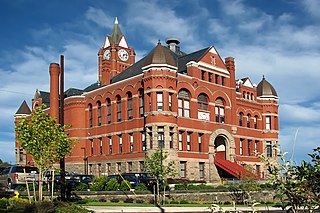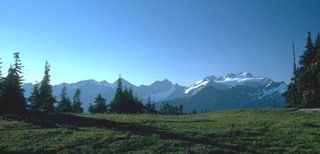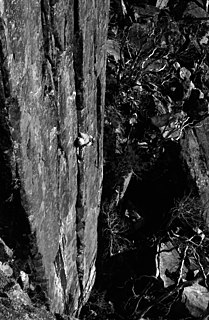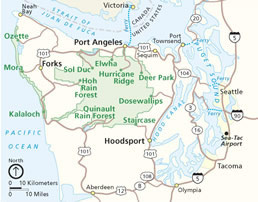
The Olympic Peninsula is the large arm of land in western Washington that lies across Puget Sound from Seattle, and contains Olympic National Park. It is bounded on the west by the Pacific Ocean, the north by the Strait of Juan de Fuca, and the east by Hood Canal. Cape Alava, the westernmost point in the contiguous United States, and Cape Flattery, the northwesternmost point, are on the peninsula. Comprising about 3600 square miles, the Olympic Peninsula contained many of the last unexplored places in the Contiguous United States. It remained largely unmapped until Arthur Dodwell and Theodore Rixon mapped most of its topography and timber resources between 1898 and 1900.
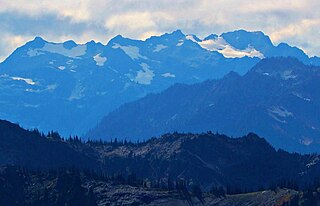
Mount Christie is high peak in the Olympic Mountains of Washington in Olympic National Park. Mount Christie is located in the Queets-Quinault group. Precipitation on Mt. Christie drains into the Elwha River on the north side, and into the Quinault River on the south side. The mountain was named to honor James Halbold Christie, who was the leader of the Seattle Press Expedition which first explored the unknown interior of the range in 1889-1890. The massif has several peaks, and the large Christie Glacier resides in the north cirque below the main summit.

Mount Deception is a peak in the Olympic Mountains in the U.S. state of Washington. It is in Olympic National Park on the Olympic Peninsula.

Mount Dana is a 6,213 feet (1,894 m) mountain summit in Jefferson County of Washington state. Set within Olympic National Park, it is part of the Bailey Range which is a subset of the Olympic Mountains. It was named in honor of Charles Dana who was an editor of The Sun, a New York newspaper. Precipitation runoff from Mount Dana drains into the Elwha River, thence into the Strait of Juan de Fuca.
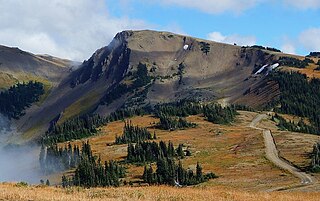
Obstruction Peak is a 6,450 feet (1,970 m) summit in the Olympic Mountains and is located in Clallam County of Washington state. It is set within Olympic National Park and is situated at the eastern end of Obstruction Point Road which is a narrow eight mile dirt road on Hurricane Ridge. The road ends below the south slope of Obstruction Peak, and a short hike leads to the summit. Its nearest higher peak is Elk Mountain, 0.46 mi (0.74 km) to the northeast. Obstruction Peak is a major triple divide point such that precipitation runoff drains into tributaries of the Elwha River, Dungeness River, and Morse Creek. All three thence empty into the Strait of Juan de Fuca.

Tamanos Mountain is a 6,790 feet (2,070 m) summit located in Mount Rainier National Park in Pierce County of Washington state. It is part of the Cascade Range. Tamanos Mountain is situated west of Governors Ridge and northeast of the Cowlitz Chimneys, all of which can be seen from the Sunrise Historic District. The name tamanos derives from Chinook Jargon and has the meaning of guardian spirit. The normal climbing access is from the Owyhigh Lakes Trail, and from the lakes scramble up the south slope to the summit.

Governors Ridge is located in Mount Rainier National Park in Pierce County of Washington state. It is part of the Cascade Range and is situated west of Cayuse Pass and 1.09 mile east of Tamanos Mountain, which is its nearest higher peak. The name honors all the governors who have served the state of Washington. The highest rocky crag on the ridge is known as Governors Peak. There is also a 40-foot leaning spire known as Governors Needle, and Barrier Peak is at the southern culmination of the ridge. The normal climbing access is from the Owyhigh Lakes Trail.

Double Peak is the descriptive name of a 6,199 feet (1,889 m) double summit located in Mount Rainier National Park in Pierce County of Washington state. Part of the Cascade Range, it is situated northwest of Shriner Peak, south of Governors Ridge, and southeast of the Cowlitz Chimneys.

Barrier Peak is a small 6,521 ft summit located in Mount Rainier National Park in Pierce County of Washington state. It is part of the Cascade Range and is situated west of Cayuse Pass, 0.53 mile west-northwest of Buell Peak, and 0.4 mile south-southwest of Governors Ridge, which is its nearest higher peak. The normal climbing access is from the Owyhigh Lakes Trail. The peak was so named because it served as a barrier between the Cayuse Pass region and the rest of Mount Rainier National Park.

Mount Appleton is a 6,000+ ft double summit mountain located in the Olympic Mountains, in Clallam County of Washington state. It is set within Olympic National Park and is situated northwest of Appleton Pass. Its nearest higher peak is South Appleton, 0.33 mi (0.53 km) to the south. Precipitation runoff from Mount Appleton drains into the Sol Duc River, and Boulder Creek which is a tributary of the Elwha River, thence into the Strait of Juan de Fuca.

Mount Jupiter is a 5,700-foot (1,700-metre) mountain summit in the Olympic Mountains and is located in Jefferson County of Washington state. It is situated in The Brothers Wilderness on land managed by Olympic National Forest. Mount Jupiter is easy to identify from Seattle, since it appears as the prominent peak between The Brothers and Mount Constance. The Jupiter name was applied by the Seattle Press Expedition in an effort to link the peak with the Greco-Roman mythological names associated with Mount Olympus. Jupiter was a Roman god on Olympus.
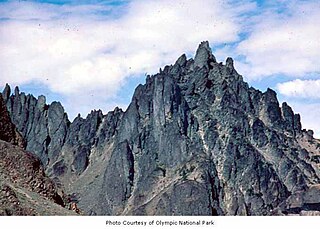
Mount Clark is a 7,528-foot (2,295-metre) mountain summit located within Olympic National Park in Jefferson County of Washington state. Its nearest higher peak is Sweat Spire on Mount Johnson, 0.26 mi (0.42 km) to the southwest. It is the second highest peak in The Needles range, which is a subrange of the Olympic Mountains, and seventh highest in the Olympic Mountains. The climbing routes on Mt. Clark start at Class 3 scrambling and range up to Class 5.5 via the central South Face. Precipitation runoff from the mountain drains into tributaries of the Dungeness River.

Mount Queets is a 6,476-foot (1,974-metre) mountain summit located deep within Olympic National Park in Jefferson County of Washington state. With a good eye and clear weather, the top of the mountain can be seen from the visitor center at Hurricane Ridge. Its nearest higher peak is Mount Meany, 0.8 mi (1.3 km) to the south. Due to heavy winter snowfalls, Mount Queets supports the Queets Glacier in a cirque on its north slope, despite its modest elevation. Precipitation runoff from the mountain drains into the headwaters of both the Elwha River and Queets River. There are scrambling routes ranging from class YDS 2 via the North Ridge, class 3 via the ridge from Mt. Meany, and class 4 via the Queets Glacier.

Mount Carrie is a 6,995-foot (2,132-metre) mountain summit located within Olympic National Park in Clallam County of Washington state. Mt. Carrie is the highest point in the Bailey Range which is a subrange of the Olympic Mountains. With a good eye and clear weather, the mountain can be seen from the visitor center at Hurricane Ridge. Its nearest higher peak is Mount Mathias which is an outlier of Mount Olympus, 6.24 mi (10.04 km) to the south. Due to heavy winter snowfalls, Mount Carrie supports the Carrie Glacier in its northeast cirque, and Fairchild Glacier on the east slope. Precipitation runoff from the mountain drains into tributaries of the Elwha River and Hoh River. There is a scrambling route via the High Divide Trail and Cat Walk.

Piro's Spire,, is a 6,259-foot (1,908-metre) basalt pinnacle summit in the Olympic Mountains and is located in Jefferson County of Washington state. It is situated in Olympic National Park and its nearest higher peak is Diamond Mountain, 1.86 miles to the west. Both are minor summits of the Mount Anderson massif, with Piro's Spire being the easternmost outlier.

Mount La Crosse, is a 6,417-foot (1,956-metre) mountain summit in the Olympic Mountains and is located in Jefferson County of Washington state. It is situated in Olympic National Park and its nearest higher peak is Mount Elk Lick, 2.29 mi (3.69 km) to the east. The Anderson massif lies 2.67 mi (4.30 km) to the north of Mount La Crosse.
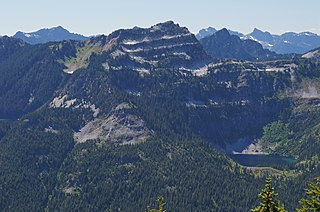
Terrace Mountain is a 6,361-foot (1,939-metre) mountain summit located in the Alpine Lakes Wilderness in eastern King County of Washington state. It's part of the Cascade Range and is situated on land managed by Mount Baker-Snoqualmie National Forest. The peak is situated 4 mi (6.4 km) north of Mount Daniel, and is surrounded by Lake Clarice, Marmot Lake, Ptarmigan Lakes, and the Terrace Lakes. Precipitation runoff from the mountain drains into tributaries of the Skykomish River. The mountain's descriptive name stems from the terrace-like appearance created by a series of benches on its east aspect.

Warrior Peak is a 7,320+ ft double summit mountain located in Olympic National Park in Jefferson County of Washington state. Warrior is the 11th highest peak in the Olympic Mountains Range. The southeast summit is the slightly higher of the two summits, the northwest peak is estimated at 7285 feet elevation. Warrior Peak is easy to identify from Seattle, since it appears as the first prominent peak immediately north of Mount Constance, which is the dominant peak on the skyline. Warrior's nearest higher peak is in fact Mount Constance, 0.8 mi (1.3 km) to the south-southeast. The first ascent of the mountain was made in 1945 by Fred Beckey, who solo climbed both summits, and named the mountain.

Mount Tom is a remote 7,076-foot (2,157-metre) mountain summit located within Olympic National Park in Jefferson County of Washington state. Its nearest higher peak is Mount Olympus, 1.76 mi (2.83 km) to the east. Due to heavy winter snowfalls, Mount Tom supports the massive White Glacier on its northeast slope, despite its modest elevation. This glacier is the westernmost glacier in the contiguous states, and the mountain the westernmost peak higher than 7000+ feet elevation. Precipitation runoff from the mountain drains into tributaries of the Hoh River.

